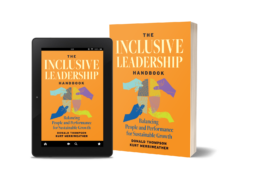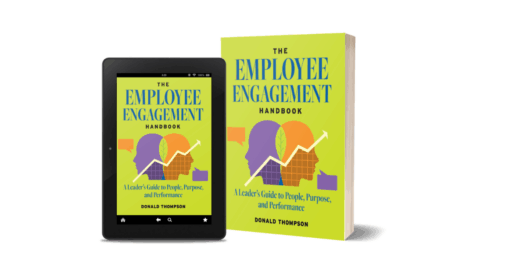Many organizations still champion the image of a charismatic leader guiding a company to success. We love reading about iconic CEOs like Steve Jobs, Howard Schultz, and Mary Barra, but gambling on the talents of one extraordinary individual isn’t a sustainable management strategy. The world is too complex for any individual leader to have all the answers. Today’s rapidly changing business environment requires a different sort of leader – one who can lead an innovative, diverse team.
The Goal is Inclusive Leadership
Leaders have to manage the day-to-day challenges of running a business while sustaining team culture, blending the personalities, ambitions, talents, and weaknesses of the people they work with to achieve organizational outcomes. This includes managing across areas of difference including generational differences, cultural difference, physical proximity, and more. Doing all this with empathy, while simultaneously focusing on the rapidly changing business environment, isn’t easy.
In a recent survey of 2,500 global business leaders, McKinsey found 10 priorities that top executives are grappling with in this “era of perpetual organizational upheaval.” Of the 10 challenges for CEOs, six involve talent management: getting the right people in the right jobs, creating inclusive workplaces, and cultivating effective leaders. By focusing on team performance and building a culture of belonging, inclusive leaders can cultivate more organizational resilience, boost efficiency, and drive retention. Inclusive leadership has also been shown to boost mental health for teams and leaders, improving employee morale and everyone’s sense of well-being.
“Diverse teams drive better decision-making and more meaningful results, not just diverse demographics but diverse backgrounds, skill sets, and job functions,” says Donald Thompson, CEO and Co-founder of The Diversity Movement. “Successful organizations integrate DEI into the everyday work experience. In today’s evolving workplace, learning inclusive leadership skills is no longer optional. It’s a core leadership skill.”
Team Challenges are Common
A culture of teamwork is more important than ever, but counterproductive behavior persists in many leadership teams. While specific challenges are unique to every team, consider the following two scenarios to illustrate a few common roadblocks that get in the way of efficient team performance.
At Company A, each member of the executive team leads their division well and consistently meets company goals. However, each person is more focused on the team they lead rather than cross-departmental cooperation that will drive overall business impact.
At Company B, the CEO is convinced they have the right answers to lead the organization and does not consider other perspectives when they are offered. Company profits are strong, but at the same time, members of the leadership team are questioning the value of their contributions. HR has received several complaints about the CEO’s behavior from other members of the executive team. The CHRO knows that if the problem behavior isn’t addressed soon, the company will start losing valuable employees.
While the teams and leaders in the above scenarios may have the best of intentions, they are short-sighted. No single person can out-perform a cohesive, diverse team. Great leadership isn’t knowing all the answers; it’s knowing how to supercharge the collective power of your team and getting the data to challenge assumptions. Inclusive leaders collect data on what their teams really care about rather than assuming they understand what they need.
Gathering The Right Data to Understand Your Team
When your team isn’t functioning as well as it could, your first thought might be, “How can I fix the problem?” But to get to the root of the issue, it’s better to first answer the question, “Why can’t my team work together?” The first step to a solution is gathering data to assess your team’s competencies and key attributes.
Most executives are familiar with individual performance assessments, whether they go through periodic reviews, participate in 360-degree reviews, or engage in other feedback programs. However, most of these methods focus on individual capabilities and ignore team strengths and weaknesses. The Diversity Movement’s inclusive leadership assessment tool, TDM LeaderView, focuses on the whole team’s development, not on any one individual. Created by trainers, educators and certified diversity executives, LeaderView’s peer assessment program is built on an ACT (assess, coach, train) model. The mix of skill evaluation, analytics, consultation, and coaching creates a framework to promote personal and collective growth.
Data is collected from individual members of the team, but the engagement doesn’t end there. LeaderView also collects peer assessments from everyone on the leadership team, with each person evaluating their colleagues. Data is sourced from people who are directly familiar with particular company challenges, the demands of leading a team, and how the team functions as a unit. Results are analyzed to formulate actionable insights for current team objectives, while also charting an individualized course for future improvement.
Coaching with an Inclusive Mindset
LeaderView provides feedback on seven inclusive leadership competencies that are part of The Diversity Movement’s inclusive leadership development framework: Communication, Collaboration, Capability, Growth Mindset, Cultural Intelligence, Reliability, and Self-awareness. Each person is evaluated in each of these areas, but the team is also analyzed according to the seven competencies.
Results are shared with individuals during one-on-one sessions with trained leadership coaches. Participants receive personalized feedback, guidance on what areas to focus on, and actionable strategies to strengthen weak areas. These sessions are emotionally and psychologically safe spaces for receiving feedback from peers. Sometimes these conversations also elicit more information about team dynamics and can identify sources of resistance.
For example, our leaders at Company A failed to see the executive team as their “first team.” Consequently, their results might show that they need to improve in the areas of Collaboration, Communication, and Self-awareness. The executives might be encouraged to consider the impact of their behavior on the team, how they can better connect as individuals, and how they can work together to make the team more efficient.
At Company B, the CEO might be resistant to change, but they might be more receptive if confronted with survey results showing weakness in the leadership competencies of Self-awareness, Communication, Collaboration, and Growth Mindset. Seeing the comments from the executive team and facing the real – and expensive – prospect of losing top talent, the CEO might have an incentive to change. Additionally, other members of the leadership team might score low on Communication, because they are reluctant to speak or contribute ideas in meetings.
Training that Amplifies Peer Support
Every team is unique, so leadership development strategies are individualized for each team and their specific requirements. Every team receives customized learning resources that help participants practice communication and improve their inclusive leadership skills. Following the one-on-one coaching sessions, facilitated workshops with the entire team continue the learning and growth by exploring how each team member can help their colleagues improve.
This process of peer support and development is the key to progress with LeaderView. No one person embodies every leadership facet, so peer collaboration is tapped to nurture proficiency. Strengths reinforce strengths, thus weaving a tapestry of trust and expertise. What begins as an assessment tool is then woven into a daily practice that amplifies communication, collaboration, trust, and efficiency.
A single leader doesn’t always have to be the person with the answers. Organizations can rely on the collective genius of the executive team to innovate and solve challenges. LeaderView provides the data that enable leadership teams to navigate change, develop a culture of collaboration, enhance productivity, and cultivate a welcoming workplace where everyone can do their best work.
Join the ranks of forward-thinking organizations that are harnessing the power of inclusive leadership to build stronger executive and managerial teams. Contact us today to learn how TDM LeaderView can transform your team and allow your organization to thrive.
Kurt Merriweather (he/him) is a Certified Diversity Executive, co-founder and vice president of Innovation for The Diversity Movement, and thought leader in building teams that integrate DEI and technology.




